Hybrid education has taken off in 2021. But what is hybrid education? And why do you need a hybrid classroom for it? How is it already being used at educational, what do teachers and students think of it and how is the technology arranged?
Getting started with the Hybrid Classroom
Hybrid education is new, so you have to put energy into it if you want to make it a success. It is important to involve all stakeholders in the realization of the hybrid classroom and to support the teachers well. Take advantage of the tips on this page!
Stakeholders
Educational institutions that have already started working with hybrid classrooms indicate that it is very important to get all the parties involved on board. This is particularly important at a time when the implementation of education is subject to constant change under great pressure.
The following stakeholders play a major role in the successful implementation of hybrid classrooms:
- Users: students, teachers, facility services
- Management: board, project leaders, steering committee, project management
- Service units: for education support processes
- Design team: facility services, IT specialists, AV specialists, educationalists (teacher support staff)
- External parties: (interior) architect, furniture suppliers, AV suppliers, IT suppliers
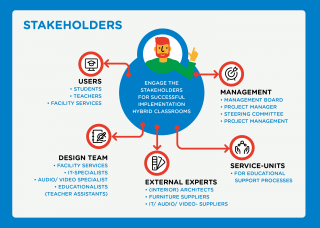
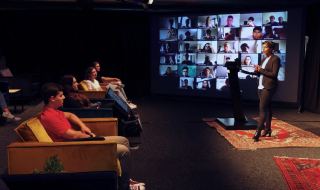
Hybrid Learning Theatre Universiteit van Amsterdam
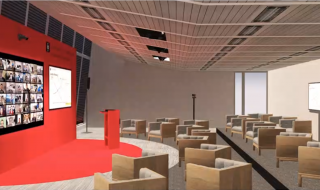
Redesign Hybrid Learning Theatre Universiteit van Amsterdam
Stakeholder Analysis
The Learning Spaces SIG Core Team has developed a tool to conduct a stakeholder analysis. This tool guides you through all the essential steps to analyze stakeholders and work towards a communication plan.
Support for lecturers
Since the start of the covid pandemic, instructors have received a great deal of support to convert their on-campus teaching to digital teaching. Interviews and a survey on hybrid classrooms in the autumn of 2020 (In Dutch) show that they receive both technical and didactic support specifically for the hybrid classroom.
Sinds het begin van de covid-pandemie krijgen docenten veel ondersteuning om hun on-campus onderwijs om te zetten naar digitaal onderwijs. Uit gesprekken over de hybrid classroom en een enquête over hybrid classrooms in najaar 2020 blijkt dat ze specifiek voor de hybrid classroom zowel technische als didactische ondersteuning krijgen.
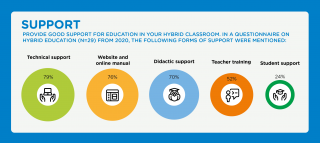
In higher education, every institution now has a central Teaching and Learning Centre with decentralized support points for lecturers. Many new vacancies have also been created to attract lecturer support staff. Sometimes, a conscious decision is made to work with a multidisciplinary team that addresses both didactic and technical aspects.
Tips & tricks from instructors and students
From the various webinars from 2020-2021, the following tips & tricks for teachers emerged for teaching in hybrid classrooms.
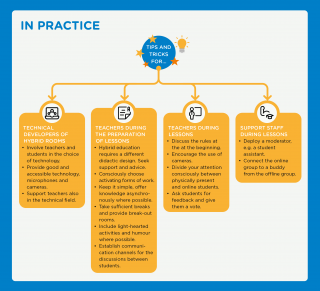
Preparation
- Hybrid education requires a different didactic design. Seek advice from your institution, for example from a Teaching and Learning Centre.
- Choose your teaching methods consciously, such as activating or student preparation.
- Consider whether you will have students work together in physical and online groups, or whether you will create mixed groups.
- Use an annotation tool, for example the Perusall platform, to have students study and discuss texts before a lecture (with each other and with you as the instructor).
- Keep it simple; offer knowledge asynchronously where possible.
- Include sufficient breaks and break-out rooms.
- Introduce light-hearted activities and humor where possible.
- Set up communication channels where students can communicate with each other.
- If necessary, use student support staff to help with the preparations.
- Have your lesson plan checked in advance by a few students and colleagues.
- Good preparation consists of a lesson plan and a technical plan.
- Do not necessarily make your lesson last as long as normal.
During class
- Discuss the rules at the beginning.
- Encourage specific camera use. See if a greeting ritual can be done so that the camera 'on' is much less of a problem.
- Consciously divide your attention between physically present and online students.
- Focus on engagement and activation (and choose other forms of covering the material).
- Students like to be heard and seen: give them attention, call them by name, etc.
- Keep the atmosphere positive, focus on motivated students.
- Make the PowerPoint presentations available much further ahead.
- Let students lead the Q&A sessions, to involve them more in the lesson.
- Ask students for feedback on the lesson.
Support during the lesson
- Use a moderator, for example a student assistant or alternatively a couple of students from the group.
- Connect each student from the online group to a buddy from the physical group.
If you want to read more, have a look at the resources about hybrid classrooms.
Teacher engagement
Teachers must be properly involved if you are developing and using new learning spaces. The core team of SURF's SIG Learning Spaces has therefore listed the actions and activities that your institution can do to ensure that instructors make use of innovative teaching spaces for the themes of organization, management, support, and communication. It has also worked out three practical examples from Utrecht University, KU Leuven, and the University of Amsterdam.
